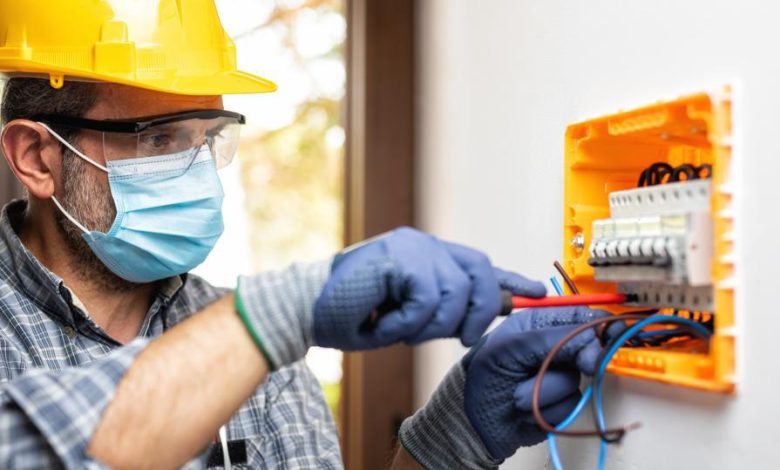Do-It-Yourself Hacks For Electrical Work

Learn these Do-It-Yourself Hacks For Electrical Work tips before tackling any electrical repairs at home
Circuit Breakers that are Simple to Read
I had to turn off a few circuit breakers in my basement, and because it’s dark down there, it was difficult to see the stamped numbers on the electrical panel. Tired of squinting, I decided to use a small amount of white painter’s caulk to make them more visible. I applied a dab to each of the numerals and wiped away the excess with my finger, leaving legible numbers behind. Overland, Casey
The Most Effective Method for Testing Breaker Switches
When I need to change a switch or outlet, I like to identify my switches and outlets so it’s easier to find out which breaker to turn off. I had to re-label everything when I moved into a new house and, I didn’t have anyone to assist me, so I turned to the radio.
I plugged it in and turned up the volume on the music. Then I flipped breaker after breaker until the radio turned off. The lighting circuits were identified using light-bulb socket adapters with receptacles integrated into the sidewalls. In an hour, I had everything tagged.
How to Save Your Outlets in a Simple Way while woodworking
I perform a lot of power sanding at my workbench while woodworking, and the sawdust was going into the outlet strip and obstructing the electrical contact. I now cover outlets I don’t use with a piece of masking tape and replace it as needed. The outlet strips are much more durable!
This Power Strip Should Be in Every Workshop
I built a power-charging station a while back to keep track of all of my battery chargers. A single power strip was used to connect all of the chargers. It did help organize my store, but it irritated me because when I turned on the power strip, all those chargers came to life, even if I only wanted to charge one battery. If the chargers are empty, it’s not a big concern, but I frequently leave cells in the cradle until they’re needed again.
I fixed the issue by purchasing a power strip with individual switches for each socket. A few brands are available on the internet. I purchased the Tripp Lite TLP76MSGB model. Six of the outlets are switched, while one is always on, and all seven are protected against surges.
Toggle the switch
Try a power strip with keyholes on the rear for attaching to the side of a cabinet to reduce the amount of plugging and unplugging and switch switching. It has a switch that turns on and off the outlets.
Connect a light and a vacuum so that when you turn on the strip, they both turn on. Then fire up your saw and get ready to go. Avoid plugging in too many things; most strips are only rated for 15 amps.
Determine wire sizes with pocket change
When adding an outlet, use the same gauge of wire as the current wiring. What is the difference between 12-gauge and 14-gauge wiring? It’s simple with a simple visual.
A nickel is roughly the thickness of 12 gauge, and a dime is around the thickness of 14 gauge. Also, check to determine if the circuit breaker is a 15-amp or a 20-amp breaker. Wire size 12-gauge or bigger is required for a 20-amp circuit.
Jig for Aligning Two Switches
Remove the guesswork from aligning duplicate switches. To access the device mounting screws, make a jig by drilling 1/2-inch holes in a double cover plate.
Screw the switches down tight through the 1/2-in. holes and level the cover plate over the switch or outlet. Remove the jig and replace it with the “authentic” cover plate.
Twisting wires is simple with this tool
Twisting on wire connections by hand, especially when they have wings, may be a real bear when you have several or heavy-gauge wires to join. Several manufacturers offer tools to make the work easier, but this one from Ideal Industries stands out.
Several of Ideal’s screwdrivers, conduit reamers, and other equipment now have a recess in the handle. The wire connector is simply inserted into the star-shaped recess as indicated. Twisting wires is considerably easier with the recess and the tool’s broad rubber grip.
Clamps for Invisible Wires
Make DIY wire clamps from a clear plastic soda bottle while running phone wire around a door frame.
1 1/2 × 1 in. strips from the bottle With a small pry bar, loosen the trim, wrap the wire in plastic, and slide it between the wall and the trim. Keep the clamp in place by nailing a 4d finish nail into the trim through the plastic if it doesn’t fit snugly.
At Home, Hide Cords
I chose to mount my flat-screen TV on the wall and set up the game components on a little table beneath it. The only drawback was a tangle of unattractive cords that hung from the wall.
I made a chase out of plywood and painted it to match my walls to disguise the cords. For the back and sides, I utilized 1/2-inch plywood, and the front panel was made of hardboard.
Soldering Wire Has Been Made Easier
I perform some minor soldering as a hobby, and I usually have trouble holding the wires together to solder them, even when using alligator clips. I’ve discovered that using a simple washer makes the job easier.
I use alligator clips to secure the wires on each side of the washer. The hole in the washer allows me to see the solder junction from practically every angle.
Sheathing Stripper Made Simple
With a sewing seam ripper, strip electrical cable sheathing! To reveal the internal wires, slide the ripper up the cable and slice through the sheathing.
Bobby Pins Have a New Use
To route small speaker or other wires around baseboards and other moulding, use old-fashioned bobby pins. Clip one end of the bobby pins to make it easier for them to slide into the gaps and retain the wire. Another wonderful application for bobby pins.
Stand for Soldering
Have you ever tried maneuvering a soldering gun while holding two strands of wire in one hand and a spool of solder in the other? With this helpful trick from reader Randy Witmyer, you can solder more successfully.
Cut two six-inch pieces of wire from a coat hanger and crimp the ends using alligator clips. Drill holes in a board, insert the alligator clip wires, and clamp the soldering wire ends. You can now use both hands to hold the rifle and the solder.
Your Broken Phone Charger Can Be Repaired With Liquid Electrical Tape
Cell phone charger cables normally only last a few years before the insulation frays at the ends. Replacement cables range in price from $8 to $30, however there is a less expensive option. If the insulation is cracked but the copper wire within is still intact, use a couple of layers of liquid electrical tape to conceal the crack. Online, the Performix and Gardner Bender brands have a lot of excellent feedback. Allow the cable to dry completely before handling it.
Cover Electrical Junction Boxes With Painter’s Tape When Removing a Popcorn Ceiling
Turn off the power to any electrical junction boxes in the ceiling and cover them with painter’s tape to keep the wiring dry while spraying water on the popcorn.
Tape the sides of the junction box together, then use a utility knife to trim around the perimeter, being careful not to nick the wires.
Conclusion
These were some of the electrical diy hacks for home owners to use at the time of emergency or in the absence of any professional electrician. To get any type of electrician services in dubai consider atdoorstep. The best professional services provider in Dubai. One of the most trusted and leading brands in dubai and we offer huge variety of professional services in Dubai.
To read more amazing article follow Dorj Blog.





